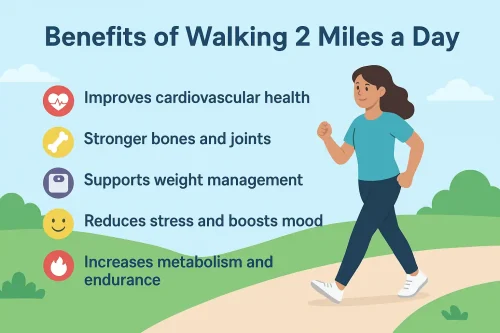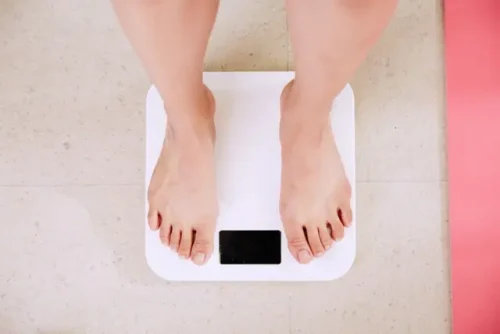
Benefits of Walking 2 Miles a Day: Health and Weight Loss
Walking 2 miles a day offers simple yet powerful health benefits, from improving heart health to supporting weight loss. Unlike more intense workouts, walking is accessible, low impact, and easy to maintain consistently. By building this habit into your daily routine, you can boost energy, burn calories, and improve overall fitness.
In this article, we will explore the benefits of walking 2 miles a day, answer common questions, and show how this routine can fit into your health and weight loss goals.
What Are the Benefits of Walking 2 Miles a Day?
Walking 2 miles a day improves cardiovascular health, strengthens bones and joints, supports weight management, reduces stress, and boosts mood. This daily habit provides consistent low-impact exercise that enhances endurance, metabolism, and mental clarity while lowering risks of conditions such as diabetes and high blood pressure.
Walking regularly is one of the most accessible forms of exercise because it requires no equipment and little planning. Two miles is a manageable distance for most people, but it still offers measurable improvements in health.
Some key benefits include:
- Improved heart health by lowering blood pressure and cholesterol
- Stronger bones and joints through regular weight-bearing movement
- Reduced stress and better mood thanks to endorphin release
- A metabolism boost that helps the body burn calories more efficiently
- Better lung function and endurance over time
For many, walking also provides the added benefit of spending time outdoors, which can enhance mental well-being. Consistency matters more than speed, so making 2 miles a daily habit is what delivers long-term benefits.
Can You Lose Weight by Walking 2 Miles a Day?
Yes, you can lose weight by walking 2 miles a day because it helps burn calories, supports fat loss, and encourages a more active lifestyle. While results depend on pace, diet, and consistency, walking this distance daily can contribute to gradual and sustainable weight management.
Walking is considered a moderate-intensity activity, making it suitable for people at different fitness levels. Although the calorie burn is less than high-intensity workouts, the key advantage is consistency. You are more likely to stick with walking than with more strenuous routines, which means better long-term results. If your goal is to lose weight in one month, walking 2 miles daily can be combined with a balanced, calorie-controlled diet.
Factors that influence weight loss when walking 2 miles include:
- Pace and intensity: A brisk walk burns more calories than a slow stroll
- Body weight: Heavier individuals burn more calories per mile
- Terrain: Inclines or uneven ground increase calorie expenditure
- Daily routine: Walking combined with balanced eating supports fat loss
For many people, walking is not just about calories but also about creating a daily routine that builds momentum toward healthier choices. Pairing a 2-mile walk with mindful nutrition and good sleep improves results even further.
How Many Calories Do You Burn Walking 2 Miles a Day?
Walking 2 miles a day typically burns between 140 and 220 calories, depending on your weight, pace, and walking conditions. A faster pace, hilly terrain, or higher body weight will increase calorie burn, while a slower pace or flat surface will reduce it.
Average calorie burn by weight:
- 120 pounds: ~140 to 150 calories
- 160 pounds: ~180 to 200 calories
- 200 pounds: ~220 calories
Other factors that affect calories burned include:
- Walking pace: Brisk walking increases energy use compared to leisurely walking
- Incline: Uphill walking or treadmill incline raises calorie burn significantly
- Consistency: Daily walks accumulate into meaningful calorie deficits over weeks
While the calorie burn from a single 2-mile walk may seem modest, the cumulative effect of walking every day adds up. Combined with balanced eating, these daily walks can create the energy deficit needed for weight loss and long-term health improvements.
How Many Steps Is 2 Miles Compared to 10,000 Steps?
Walking 2 miles is roughly 4,000 to 4,500 steps, depending on your stride length and pace. Since the widely cited daily goal is 10,000 steps, a 2-mile walk gets you about 40 to 45% of the way there.
Here’s how it breaks down:
- Shorter stride (2.0 ft): ~5,280 steps in 2 miles
- Average stride (2.5 ft): ~4,200 steps in 2 miles
- Longer stride (3.0 ft): ~3,520 steps in 2 miles
Compared to the 10,000-step benchmark:
- 2 miles = about 40 to 45% of daily step goal
- 4 miles = about 80 to 90% of daily step goal
- 5 miles = close to 10,000 steps for most people
This comparison shows that while 2 miles of walking daily provides a strong foundation, most adults will need additional activity throughout the day, such as taking the stairs, walking during calls, or adding an evening stroll, to consistently hit the 10,000-step target.
Is Walking 2 Miles a Day Enough for Weight Loss?
Walking 2 miles a day can contribute to weight loss, but it may not be enough on its own for everyone. The calorie burn from a 2-mile walk typically ranges from 150 to 250 calories, depending on your weight and walking speed, which can support gradual fat loss when combined with a healthy diet.
Factors that influence results:
- Calorie balance: To lose weight, you must burn more calories than you consume. A 2-mile walk helps, but dietary choices remain the primary driver.
- Body weight: Heavier individuals burn more calories per mile, so weight loss may occur faster.
- Pace and intensity: Walking briskly (15 to 18 minutes per mile) burns more calories than a slow stroll.
- Consistency: Walking 2 miles daily adds up to 14 miles per week, creating steady calorie expenditure over time.
Example:
- A person weighing 160 pounds burns about 190 calories walking 2 miles at a moderate pace. Over 7 days, this equals 1,330 calories burned, or roughly one-third of a pound of fat loss, assuming no change in diet.
If your goal is significant weight loss, walking 2 miles daily is a strong starting point, but pairing it with mindful eating and other forms of physical activity will deliver better results.
How Long Does It Take to Walk 2 Miles a Day?
Walking 2 miles a day usually takes 30 to 45 minutes, depending on your pace, fitness level, and terrain. A moderate walking speed of 3 miles per hour translates to about 20 minutes per mile, while brisk walking can reduce this time slightly.
Factors that affect walking duration:
- Pace: Leisurely walking may take closer to 50 minutes, brisk walking closer to 30 minutes.
- Terrain: Hills, uneven surfaces, or trails can increase time.
- Fitness level: Beginners may take longer, while regular walkers may finish faster.
- Incline: Walking uphill or using a treadmill incline adds intensity and slightly more time.
Tips for optimizing your 2-mile walk:
- Track your pace with a fitness app or smartwatch to ensure you maintain moderate intensity
- Break your walk into two 1-mile sessions if time is limited
- Include short bursts of brisk walking or light jogging to increase calorie burn
By consistently walking 2 miles daily, even at a moderate pace, you can improve cardiovascular health, endurance, and calorie expenditure while fitting the routine into a manageable 30 to 45 minute window.
Does Walking 2 Miles a Day Help Reduce Belly Fat?
Walking 2 miles a day can help reduce belly fat as part of an overall calorie deficit, but it cannot target fat loss in one specific area. Regular walking increases calorie burn and supports fat loss throughout the body, which over time can contribute to a slimmer waistline.
Key points to consider:
- Overall fat loss: Spot reduction is a myth; walking contributes to total body fat reduction.
- Intensity matters: Brisk walking or adding inclines increases calorie burn and fat utilization.
- Consistency: Daily walks help create a sustained calorie deficit for long-term results.
- Lifestyle factors: Combining walking with a balanced diet and proper sleep enhances belly fat reduction.
Example:
- Walking 2 miles daily at a moderate pace can burn roughly 1,300 to 1,500 calories per week, equivalent to about half a pound of fat loss, supporting gradual reductions in abdominal fat over time.
Adding variety, such as interval walking or light resistance exercises after your walk, can further improve body composition and waistline appearance.
Is It Better to Walk Faster or Longer for Weight Loss?
Both walking faster and walking longer can support weight loss, but increasing walking pace tends to burn more calories per minute, while walking longer increases total energy expenditure. Choosing the right balance depends on your fitness level, schedule, and personal goals.
Consider these factors:
- Pace (intensity): Brisk walking at 15 to 18 minutes per mile elevates heart rate and engages more muscles, boosting calorie burn.
- Duration: Extending your walk increases total calories burned, even at a moderate pace.
- Combination approach: Alternating brisk segments with longer moderate walks maximizes fat burning and cardiovascular benefits.
- Fitness level: Beginners may benefit from longer moderate walks, while experienced walkers can add speed or intervals for more impact.
Example:
- A 160-pound person walking 2 miles briskly (16 minutes per mile) burns roughly 190 calories. Walking the same 2 miles at a slower pace may burn only 140 to 150 calories. Extending that slower walk to 3 miles would surpass the higher-intensity 2-mile burn.
Ultimately, consistency is key. Whether you walk faster or longer, daily activity combined with a balanced diet produces the best results for weight management and overall health.
Read More: Motivation Fitness Tips for Beginners
What Is the Best Time of Day to Walk for Health and Weight Loss?
The best time of day to walk for health and weight loss is whenever you can consistently fit it into your routine. Morning walks may boost energy and metabolism, while evening walks can aid digestion and stress relief. Consistency matters more than the exact hour.
Key considerations:
- Morning walks: Can jumpstart metabolism, improve alertness, and help establish a routine.
- Afternoon or evening walks: May help manage stress, support digestion after meals, and provide a natural cooldown after work.
- Personal schedule: Choose a time you can maintain daily, ensuring the habit sticks.
- Environmental factors: Outdoor conditions like temperature, air quality, and daylight can influence your preferred timing.
Example:
- A 30 to 45 minute walk in the morning before breakfast can help some individuals burn stored fat efficiently. Conversely, a walk after work can relieve tension and improve mood, supporting overall wellness.
Ultimately, there is no single “best” time for everyone. Prioritize regularity and enjoy your walk, whether it is early morning, midday, or evening, to maximize both health and weight management benefits.
Does Walking Change Your Body Shape Over Time?
Yes, walking regularly can gradually change your body shape by toning muscles, reducing overall body fat, and improving posture. While it may not create dramatic muscle growth, consistent walking strengthens the legs, glutes, and core, contributing to a leaner, more defined appearance.
How walking affects your body:
- Legs and glutes: Repeated movement engages the calves, thighs, and glute muscles, enhancing tone.
- Core and posture: Maintaining an upright posture while walking strengthens the core and improves alignment.
- Waistline: Walking helps reduce overall fat, including abdominal fat, which can slim the waist over time.
- Arms: Swinging your arms naturally engages upper body muscles for mild toning.
Example:
- Walking 2 miles daily for several months can noticeably improve muscle definition benefits in the lower body, reduce fat, and create a more streamlined shape without heavy resistance training.
For more visible changes, consider adding brisk intervals, inclines, or light hand weights to your walks. Combined with a healthy diet and consistent activity, walking can meaningfully reshape your body over time.
Is Walking Outside Better Than Walking on a Treadmill?
Both walking outside and walking on a treadmill offer health and weight loss benefits, but each has unique advantages. Outdoor walking engages more stabilizing muscles and provides fresh air and natural scenery, while treadmill walking allows for controlled pace, incline, and safer conditions.
Key differences:
- Muscle engagement: Uneven terrain outdoors recruits stabilizing muscles more than a treadmill.
- Calorie burn: Walking uphill or on varied terrain outdoors may burn more calories.
- Consistency and safety: Treadmills provide a controlled environment and reduce the risk of tripping or bad weather interruptions.
- Mental benefits: Outdoor walks can boost mood, reduce stress, and improve focus through exposure to sunlight and nature.
Example:
- A 2-mile walk on a treadmill at a 2% incline can burn a similar number of calories as walking the same distance outdoors on a flat, even path. Introducing hills or trails outside increases both intensity and calorie expenditure.
Ultimately, the best option is the one you enjoy and can do consistently. Alternating between treadmill and outdoor walks can combine the benefits of both methods.
Tips to Maximize the Benefits of Walking 2 Miles a Day
To maintain a healthy weight while walking 2 miles a day, focus on intensity, consistency, and healthy habits. Increasing your pace, maintaining good posture, and pairing walks with balanced nutrition can boost calorie burn, support fat loss, and help you sustain a healthy weight over time.
Ways to enhance your 2-mile walk:
- Maintain a brisk pace: Aim for 15 to 18 minutes per mile to elevate heart rate and boost calorie burn.
- Add inclines or hills: Walking uphill engages more muscles and increases energy expenditure.
- Use proper posture: Keep shoulders back, core engaged, and swing your arms for better muscle activation.
- Incorporate intervals: Alternate between moderate and brisk pace for improved cardiovascular fitness.
- Track your progress: Use a step counter or fitness app to monitor distance, pace, and consistency.
- Combine with strength exercises: Light dumbbells or resistance bands can add upper body toning.
- Stay hydrated and fuel appropriately: Drinking water and having a small snack if needed supports energy and recovery.
Example:
- Walking 2 miles at a brisk pace with intervals of 1 to 2 minutes of faster walking can increase calories burned by 15 to 20% compared to a steady pace.
By applying these tips, you can maximize fat burning, cardiovascular benefits, and muscle tone, making your 2-mile daily walk more effective and enjoyable.
Read More: Running vs Walking for Weight Loss: Which Works Better for You?
Wrapping Up
Walking 2 miles a day offers measurable benefits for health, fitness, and weight management. It can improve mood, boost metabolism, support gradual fat loss, tone muscles, and enhance overall body shape. By combining consistent walking with proper nutrition, hydration, and occasional intensity adjustments, you can maximize these benefits while creating a sustainable daily routine.
Frequently Asked Questions
Q: How soon will I see results from walking 2 miles a day?
A: You may notice increased energy and improved mood within 1 to 2 weeks, while visible changes in weight or body shape often appear after 4 to 6 weeks of consistently walking 2 miles daily.
Q: Why am I not losing weight walking 2 miles a day?
A: Not losing weight walking 2 miles daily may be due to diet, pace, or inconsistency. Brisk walking combined with mindful eating and regular activity increases calorie burn and supports more noticeable results.
Q: Can walking 2 miles a day improve mental health?
A: Yes, walking 2 miles daily boosts mood, reduces stress, and enhances focus by increasing endorphins and providing time outdoors for relaxation and mental clarity.
Q: Is it better to walk on an empty stomach or after eating?
A: Walking before meals may help some people burn fat more efficiently, while walking after a light meal provides energy for a stronger workout. Choose what feels comfortable for your body.
Q: Does walking make your legs slimmer or bigger?
A: Walking 2 miles a day generally tones leg muscles and burns calories, making your legs leaner rather than significantly larger, offering gradual, low-impact improvements in shape and definition over time.




